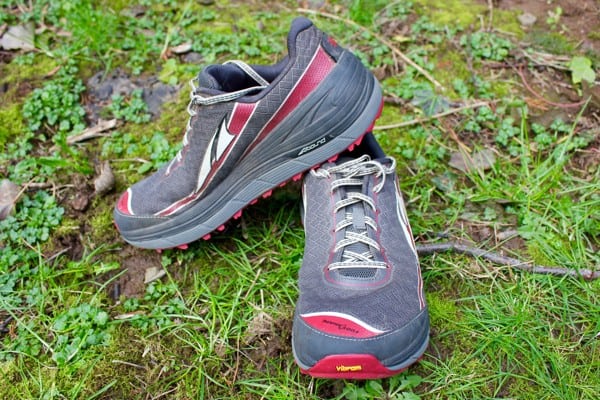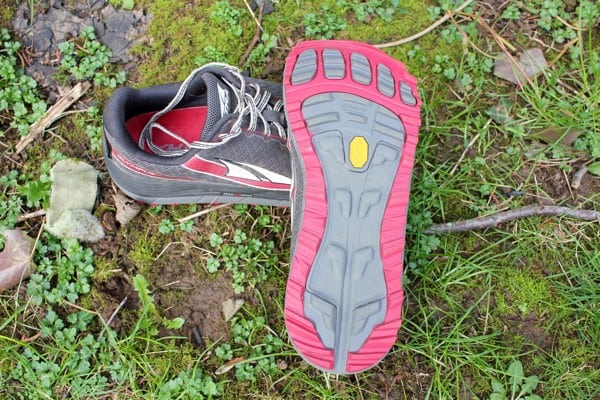Our Favorite Trail Running Shoes
Check out our Best Trail Running Shoes article to learn about our current favorite trail running shoes!
Altra Olympus 2.0 Review
The Altra Olympus 2.0 ($150) is the third version of Altra’s popular Olympus model. While minor-to-moderate changes are seen in the shoe’s upper and midsole, distinct outsole changes enhance its performance on all types of terrain where grip, cushion, or some combination of both come into play. Watch this video review to learn more about the Olympus 2.0.
[Click here if you can’t see the video above.]
Altra Olympus 2.0 Review Transcript
Hey, and welcome to Trail Trials, the video review section of iRunFar.com. My name is Travis Liles, and in today’s video we’re going to take a look at the Altra Olympus 2.0.
The Altra Olympus 2.0 is actually the third iteration of this specific model. It weighs in at just around 11.0 ounces in a men’s size 9. It has a 0mm heel-toe drop. It has a 36mm foam midsole which puts it in the maximalist category. The biggest update that I think anybody who is a previous Olympus user is looking for is it’s added the Vibram Megagrip outsole. With that brief introduction, let’s get up close and personal and see what these shoes are all about.
Upper
We’ll go ahead and start at the upper and then work our way down, which is the reverse of what I usually do, but because the outsole is kind of the main attraction on this update, we’ll finish up there. What you’ll notice here is a little bit of a departure from what we’ve seen in the past from Altra Olympus—way less overlays which is pretty consistent with what you’re seeing with their new design. This is very similar to what the Lone Peak 2.5 has—lots of mesh, really breathable. It’s a lightweight upper. You’ll see that pretty much throughout. It’s a very consistent upper with a little bit of this laminated seam on here. It isn’t sewn on but glued with the logo here and a little bit of a stripe. You’ll see that reflected here on both sides and then of course through the back as well and even more of that lamination that is sewed for reinforcement here around the laces as well. When you look at this, you’ll notice it’s a little bit narrow. It’s not a wide path here that your laces go on. If you’ve got really narrow feet, this could be a little bit hard to cinch down. I think I have fairly average feet when it comes to that, and I did not have a problem. You will notice that I laced up through here with the lace lock to cinch the heel down a little bit better, but I have a narrow heel, so that’s something I kind of struggle with with all shoes. Again, kind of mesh all throughout. There’s really not a whole lot to say here in terms of what this is. It’s very simple. It’s lightweight. I really felt like it’s stable and does a nice job of kind of keeping my foot where it needs to be while still allowing enough room here in the toe box, which is something that Altra really touts a lot, its foot-shaped toe box. So you’ll notice it’s really wide. It sort of curves toward your big toe and does the shape of your foot. My feet splay out really well, but I don’t feel like I’m swimming in here. I feel like everything kind of locks down. This little bit of material here gives it a good little bit of structure that’s not mesh so you’re not blowing out toward the side. You get that on both sides.
From a toe-bumper standpoint, you have the apex of the outsole that wraps around that you see on a bunch of shoes and then some full leather or suede-like material here that’s a little bit hardened, perhaps even some rubberized vinyl or something like that that’s under here that’s going to add a little bit more structure to the toe. Now, this is not a very massive toe bumper. You’ll see where the majority is here. This is really sturdy. On the sides, not so much as it’s really more of a structural thing. I’d say the positive thing is because this is a maximalist shoe, your foot is a little higher off the ground to begin with, so maybe you’re not going to toe quite as easily as you would in something a little lower profile. Overall, I didn’t have any problems hitting things or noticing this was a weak point in the shoe.
As we sort of make our way to the midsole, I’m going to call out a couple of things here. These existed on the previous version of the shoe, and it’s this little bit of a stability cage. You can see my hand in here kind of moving that back and forth. That also exists over here. There’s this… I don’t know… section of the shoe that you sort of sit down inside. Here on the medial side, my finger is probably about right here. This adds to the stability and some of the good fit that I feel like for a maximalist shoe keeps it so your foot isn’t all over the place and kind of falling off the top of these. It adds a bit of extra weight. Aesthetically, maybe it’s not a beautiful thing. But I really feel like it was a good fit, and I think this area in here really adds to that and really lets your foot sort of sit down inside of the midsole versus feeling like you’re running on top of it. Actually, I guess I’ll call out one more thing—the gaiter trap. You’ll see this on all Altra shoes. If you wear gaiters, you have a little Velcro piece built in already.

The Altra Olympus 2.0. All photos: Travis Liles
Midsole
As we move our way down to the midsole, you’ll see that it’s kind of sandwiched. You’ve got this black plastic here that’s a little bit higher. Again, if you pull out the insole, you’ll sit down inside of this a little bit, not very far, but inside of this black rubber portion. You have a slightly softer foam here in the grey that’s on the bottom. There’s not stability in here. There’s not any posting. There’s not anything that’s doing any sort of correction. I will say when you put your foot in here, though, versus tilting inward, it has a slight tilt outward. It’s not 100% flat. It has a little bit of a tilt which for me as someone that generally has to have either a shoe that is slightly stability or in terms of Altra, a lot of times I’ll use their stability wedge in my shoe, I didn’t have to do that with these. So there may be a little bit more of a broad audience for those of us that are not 100% neutral. It will help you out later in a race when form and all those sorts of things fall down.
You have a softer foam here on the bottom. I think with any maximalist shoe, the positive side is more cushion. When you’re on the trail, things sort of go into this. If I step on something sharp, versus deflecting out, it sort of absorbs into the midsole which I think maybe adds to that idea of it doesn’t feel kind of wobbly. If this was a real stiff type of foam, I feel like there could be some downsides there in terms of maybe making you rock farther inward or outward spraining an ankle or fall down or whatever it is. But because it deflects inward, it does a nice job of keeping things together. I will say, though, that they’re far more responsive than I anticipated. I probably think that a lot throughout this entire shoe in that it kept exceeding what I expected. I did even speed workouts in these just to do it and really felt like even this is a more softer type of foam that perhaps in the past you may feel like is going to slow you down or kind of feel like it’s dragging, I felt like there was a lot of good return in these and felt like the type of output I was able to get without feeling like I had some big marshmallow running on my foot.

The Altra Olympus 2.0 upper and midsole.
Outsole
Lastly, what I think we’ll do is switch over to this outsole. If you are someone that has worn the Olympus in the past, you know that the major downfall was the outsole. Version 1, it was a very simply sort of blade-y type of outsole. They increased the lug depth and kept the same tread pattern in the 1.5. And then in the 2.0, they’ve completely revamped it, and I would say it’s definitely for the better.
Let’s talk about what’s going on here. They used the Vibram Megagrip, which they called out right here in this little section of the shoe. That is used all the way around the shoe—on the red parts, these grey parts here and this section as well that sits right underneath the ball of your foot. What’s not actual outsole is all this other grey section. This, except for the heel portion here, this whole middle section is just soft foam. It’s effectively the midsole foam. While you’re getting some weight savings there, you’re losing a little bit of that tread. This is going to be more likely to get worn down. Things can get stuck in there. Again, you’re on a maximalist platform, so something poking through and getting to your foot is probably not super probable to happen, but you do have a little bit more exposure here. It will experience more wear and tear, but this isn’t anything you don’t see on other shoe manufacturers either. For weight-saving purposes, they don’t do the whole thing with their Vibram Megagrip.
To the tread pattern here, I think it’s a very classic tread pattern of forward and reverse lugs. That transition happens right here at the middle of your foot. You can see where these start to turn backward for descending, and these are forward. Through here, I really feel like all of these bit and did a really awesome job without being overly aggressive. This is one of the better non-hyper-luggy outsoles that I’ve run with. I was super impressed with these. They did a nice job with wet stuff, on rocks, on roots, on muddy trails, in snow, slush… without being the extreme examples of ice and things like that where really no shoe is going to help you out. In terms of a shoe that I didn’t have to put a traction device on, I felt like they really knocked it out of the park with this outsole here. I was really, really impressed with it especially for the lug depth not being super, super deep. Definitely all around, they did an awesome job with these. Megagrip is sticky and is supposed to work well across all types of different surfaces. Again, this lug pattern here of these teeth up front really dig in and really do an awesome job. I’m super excited about that. With that, let’s give final impressions.

The Altra Olympus 2.0 outsole.
Overall Impressions
In closing, I think the Altra Olympus 2.0 is a really good example of how Altra as a company has grown. You see higher-quality materials. You see fewer blowouts. You see the feedback they’ve listened to from their team that they sponsor as well as their vocal and supportive runners that use their brand. Gone are some of the more wonky things that I think I’d seen before in terms of fit and finish. The tongue is long enough. It holds down on the foot really well. It’s not a sloppy upper. This heel isn’t puffy and overblown. I think they did this just about right. It’s probably one of the most approachable trail running shoes that Altra has put out to date in terms of mass-market appeal, or just about anybody should be able to wear these.
The big thing here, of course, is the outsole with the Vibram Megagrip. As I talked about in the review, I really am pleased with these. They worked on a variety of surfaces—mud, road, track, lots of rain, and rocks and roots and all that kind of stuff that you could really put a shoe like this through. This grip with a maximalist, I would have been very skeptical about its ability to be stable and something that you could get on some technical terrain on. This shoe definitely made it believable that it was possible to have a maximalist shoe that really has a good fit and that you can power through and not worry about stability and not feeling wobbly and all over the place. Hopefully, we see more of the Vibram Megagrip throughout the whole Altra line—if not, at least mimicking the tread pattern because I think this has got the best grip of any shoe they’ve put out to date.
Call for Comments
With that, please leave your comments or questions below. Thanks for watching. We’ll catch you next time.
